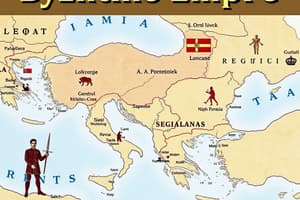Podcast
Questions and Answers
Which of the following best describes the geographical location of the ancient Kievan Rus' state?
Which of the following best describes the geographical location of the ancient Kievan Rus' state?
- Modern-day Russia
- Central Asia
- The Balkan Peninsula
- Southern regions of modern Ukraine (correct)
What was the primary reason the Byzantine Empire paid close attention to the various groups inhabiting the areas north of the Black Sea?
What was the primary reason the Byzantine Empire paid close attention to the various groups inhabiting the areas north of the Black Sea?
- Byzantine desire to expand their borders.
- The economic significance of Greek settlements in Taurica (correct)
- Byzantine interest in converting them to christianity
- The threat these groups posed to the Empire's military strength
Which of these groups is NOT mentioned as inhabiting the areas that would eventually become the Kievan Rus'?
Which of these groups is NOT mentioned as inhabiting the areas that would eventually become the Kievan Rus'?
- Romans (correct)
- Slavs
- Huns
- Scythians
What evidence supports the long-standing presence and strength of the Greek civilization in the Crimean Peninsula?
What evidence supports the long-standing presence and strength of the Greek civilization in the Crimean Peninsula?
Which historians provided important insights about the areas around the Black Sea according to the text?
Which historians provided important insights about the areas around the Black Sea according to the text?
Flashcards
Kievan Rus'
Kievan Rus'
The ancient Russian state, established in the 9th century, located in modern-day Ukraine, particularly the southern regions.
Tribes inhabiting the Kievan Rus' region
Tribes inhabiting the Kievan Rus' region
A group of people of various origins who inhabited the region of Kievan Rus' before the Slavs, including Cimmerians, Scythians, Sarmatians, Persians, Goths, Huns, Avars, and Khazars.
Greek Presence in Crimea
Greek Presence in Crimea
The Greek presence in the Crimean Peninsula (Taurica) since ancient times, marked by Greek settlements and the establishment of Christianity in the 4th century.
Greek Sources on the Region
Greek Sources on the Region
Signup and view all the flashcards
Greek Archaeological Evidence in Crimea
Greek Archaeological Evidence in Crimea
Signup and view all the flashcards
Study Notes
The Russians in the Byzantine Sphere of Influence
- The examination of Russian presence within the Byzantine Empire necessitates understanding their origins and early interactions.
- The area of the early Russian state (Kievan Rus') largely corresponded to modern Ukraine.
- The region was inhabited by various groups throughout history, including the Cimmerians, Scythians, Sarmatians, Persians, Goths, Huns, Avars, Khazars, and Slavs.
- The Byzantine Empire closely monitored these groups' movements, due to historical ties and trade routes.
- The Byzantine Empire was largely influenced by the existence of Greek settlements in the Crimea (Tauric Chersonesus), starting in the 4th century CE with the establishment of Christianity.
- Greek presence in the region contributed to economic prosperity.
- Greek scholars and historians such as Herodotus and Strabo, and later Byzantine historians of the sixth century CE provided accounts of the Russian people and their land.
- Inscriptions and carvings from pre-Christian times in Crimea offer evidence of flourishing Greek culture in the region.
- These findings confirm the presence of a significant and active Greek cultural presence in the area.
Studying That Suits You
Use AI to generate personalized quizzes and flashcards to suit your learning preferences.




